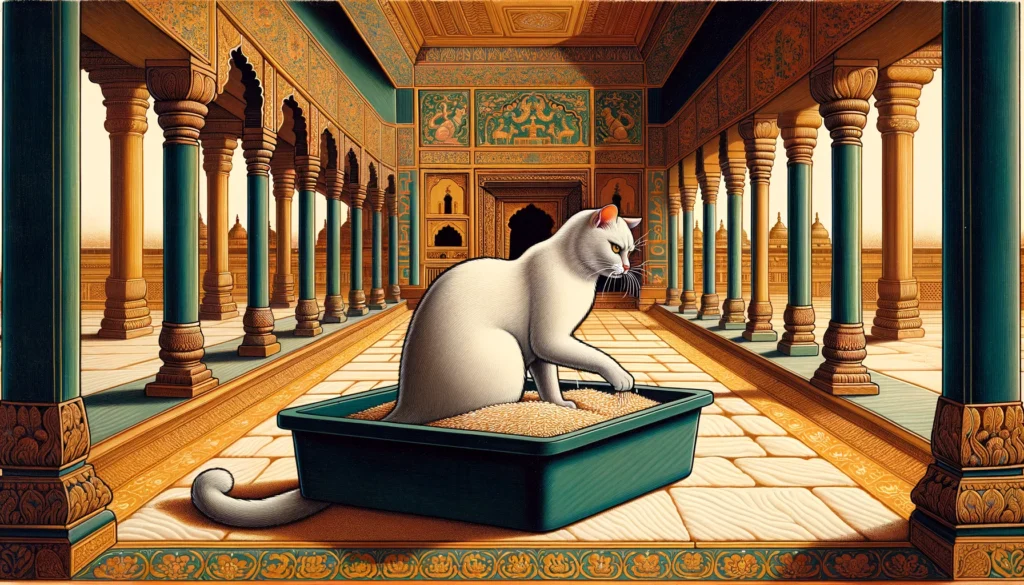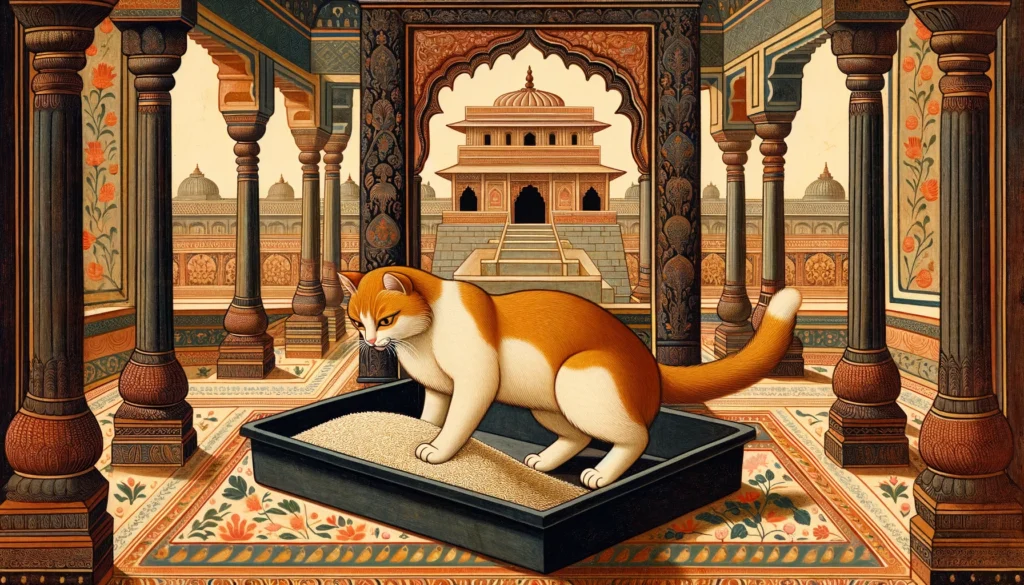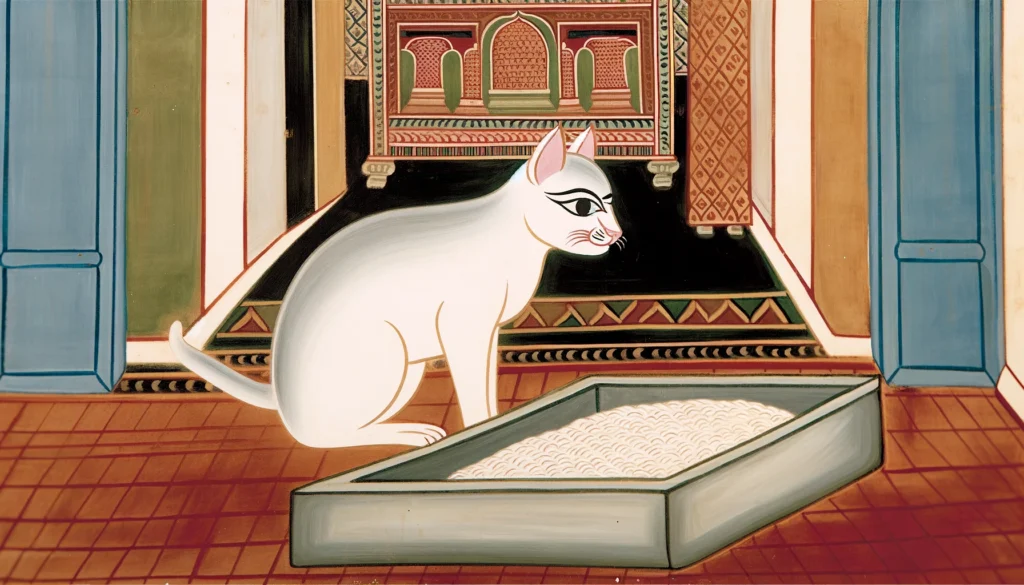Curious about shaking up your feline friend’s bathroom routine with something grainy? You might ponder, “can i use rice as cat litter?” Yes, you can, and it’s a scoop full of surprises! Cat litter made from rice not only treads lightly on our planet but also promises a sneeze-free zone for you and your whiskered companion.
Rice brings a buffet of benefits, serving as a natural litter solution that’s both paw-friendly and purse-friendly. But before you pour that rice bowl into the litter tray, let’s dig into the nitty-gritty of this pantry staple turned litter marvel.
Key Takeaways: Rice as an Alternative Cat Litter
- Eco-Friendly Choice: Rice, as a natural litter solution, is biodegradable and sustainable, reducing environmental footprint.
- Health and Comfort: Its hypoallergenic and low dust properties make rice an excellent option for cats and owners with allergies or respiratory issues.
- Maintenance and Care: Despite its benefits, rice requires more frequent changes and doesn’t clump, which can be a drawback for some pet owners.
- Pest Attraction and Odor Control: Be aware of the potential for attracting pests and the limited odor control compared to commercial cat litters.
- DIY Potential: Exploring DIY cat litter with rice grains can be a cost-effective, creative, and eco-friendly endeavor for pet owners.

You may also like: 20 Environmentally Conscious Cat Litter Alternatives
Advantages of Using Rice as Cat Litter
Rice offers several benefits as a natural litter solution, highlighting its biodegradable cat litter options.
1. Biodegradable Nature of Rice
Rice, as a cat litter, naturally breaks down, turning into earth-friendly compost rather than clogging up landfills. This biodegradable cat litter option not only eases your environmental conscience but also supports a cleaner planet.
- Eco-Friendly: Decomposes into harmless substances, lessening environmental impact.
- Waste Reduction: Minimizes the volume of non-degradable waste in landfills.
- Sustainable Choice: Supports ecological balance by using a renewable resource.
- Compostable: After use, rice can contribute to nutrient-rich soil, closing the waste loop.
2. Low Dust and Hypoallergenic Qualities
Using rices as cat litters benefits both the lungs and noses, offering a breath of fresh air for those with respiratory issues. Its low dust and hypoallergenic traits make it a standout choice for health-conscious pet owners.
- Reduced Respiratory Irritants: Less dust means fewer airborne particles to inhale.
- Allergy-Friendly: Minimal allergens help prevent reactions in both cats and humans.
- Cleaner Home Environment: Low dust keeps your living spaces cleaner and more comfortable.
- Gentle for Sensitive Systems: Ideal for cats and owners with respiratory sensitivities or allergies.
3. Sustainable and Renewable
Rice for feline waste management plays a significant part in promoting sustainability, embodying the essence of a renewable resource. It’s a key player in natural litter solutions with rice, harmonizing pet care with planet care.
- Eco-conscious Option: Utilizes a replenishable resource, lessening environmental depletion.
- Cyclical Resource: Rice cultivation is sustainable, ensuring a consistent supply without harming the planet.
- Energy Efficient: Requires less processing and energy to convert into litter compared to traditional materials.
- Supports Eco-Systems: Encourages agricultural practices that benefit the environment and economy.
4. Absorbent Materials for Cat Boxes
Rice excels in soaking up urine, which keeps the litter box dry and comfortable for feline friends. Its absorbency is key to a clean and odor-controlled environment.
- High Absorbency: Quickly absorbs liquids to prevent pooling.
- Dry Surface: Maintains a dry top layer, enhancing comfort for cats.
- Effective Moisture Management: Keeps the litter box environment less hospitable for bacteria.
5. Soft and Gentle on Paws
The natural, soft texture of rice proves to be kind on cat paws, providing a soothing litter experience, particularly for those with sensitivities.
- Paw-Friendly: Gentle on cat paws, reducing irritation.
- Ideal for Delicate Paws: Especially good for declawed or sensitive cats.
- Comfortable Use: Encourages regular use of the litter box without discomfort.
6. Reduced Tracking
Rice-based litter, with its heavier grains, helps keep your home cleaner by reducing the amount of litter tracked outside the box.
- Less Scatter: Heavier grains stay in the box better.
- Cleaner Floors: Minimizes the spread of litter through the home.
- Easy Maintenance: Simplifies cleaning around the litter area.
7. Natural Odor Control
Thanks to its natural absorbency, rice effectively controls odors, making it a reliable choice for maintaining a fresh-smelling home.
- Odor Absorption: Neutralizes urine smells efficiently.
- Fresh Environment: Contributes to a more pleasant home atmosphere.
- Sustainable Freshness: Offers a naturally clean scent without artificial fragrances.
8. Cost-Effective
Rice can serve as an economical litter choice, particularly where it’s a staple and prices are low, offering budget-friendly pet care.
- Affordable: Often cheaper than many commercial cat litters.
- Readily Available: In regions where rice is common, it’s easily accessible.
- Long-Lasting Use: Efficient use of material can provide lasting litter solutions.
9. Chemical-Free
Free from chemicals and synthetic fragrances, rice is a safer and healthier litter alternative for both cats and their human companions.
- Non-Toxic: Safe if ingested in small quantities.
- Hypoallergenic: Lowers the risk of allergic reactions.
- Environmentally Safe: Free from harmful chemicals, better for the planet.
10. DIY Cat Litter with Rice Grains
Creating your own DIY cat litter with rice grains not only showcases your creativity but also aligns with eco-friendly practices, providing a sustainable litter solution right from your kitchen.
- Customizable Mix: Tailor the litter to your cat’s preferences and needs.
- Eco-Friendly Crafting: Supports sustainable living by repurposing readily available rice.
- Cost Savings: Potentially reduces expenses compared to purchasing commercial litter.
- Innovative Recycling: Turns a common pantry item into a valuable pet care product.

You may also like: 20 Environmentally Conscious Cat Litter Alternatives
Disadvantages of Using Rice as Cat Litter
Despite its merits, there are downsides to utilizing rice for cat litter that must be considered, from its non-clumping nature to practical challenges in everyday use.
1. Non-Clumping Nature
Rice’s inability to clump like commercial cat litter complicates waste removal, requiring more effort during clean-up.
- Frequent Cleaning Needed: Without clumping, waste mixes with clean litter.
- Less Convenient: More labor-intensive to sift and remove waste.
- Increased Usage: More litter is used up as clean grains get discarded along with waste.
2. Decomposition and Odor
When wet, rice tends to decompose, which can lead to unpleasant odors, challenging the freshness of your home.
- Decomposition Smell: Can become pungent if not changed regularly.
- Mold Growth: Moisture can lead to fungal and bacterial growth.
- Regular Replacement: Needs more frequent changing to prevent odor.
3. Risk of Attracting Pests
Being a food product, rice may attract unwanted guests like insects or rodents, adding a pest control dimension to litter management.
- Pest Attraction: Food nature of rice lures in pests.
- Storage Care: Requires secure, pest-proof storage.
- Home Safety: Increases the need for vigilance to prevent infestations.
4. Maintenance and Frequency of Change
Rice litter requires more frequent changes due to its breakdown tendency, adding to the daily maintenance workload.
- Increased Labor: Regular cleaning and changing are imperative.
- Higher Consumption: Goes through litter faster than conventional types.
- Time-Consuming: More of your time is spent managing the litter box.
5. Ingestion Risk
The risk of cats eating rice grains poses a threat to their health, potentially causing gastrointestinal discomfort or blockages.
- Health Hazard: Ingested rice can lead to digestive issues.
- Monitoring Required: Keep an eye on your cat’s litter eating habits.
- Veterinary Concerns: Ingestion could necessitate a vet visit.
6. Limited Odor Control
Though rice can absorb urine, its odor control is less effective compared to cat litters designed specifically for smell management.
- Smell Containment: Struggles to trap odors effectively.
- Frequent Changes: Needs replacing often to maintain a fresh scent.
- Odor Management: May require additional deodorizers.
7. Messy Cleanup
Wet rice litter sticks to surfaces and paws, making the cleanup process messier and more tedious than with traditional litters.
- Sticky Mess: Clings to litter box and cat paws.
- Difficult to Clean: Harder to remove from the box and floors.
- Unpleasant Texture: Becomes gooey and unpleasant when wet.
8. Availability and Practicality
The practicality of using rice as cat litter is questionable due to limited availability and suitability in different living environments.
- Market Scarcity: Rice-based litter products are not mainstream.
- DIY Constraints: Homemade versions may not meet all litter needs.
- Lifestyle Fit: May not be suitable for all cats or households.
9. Ethical and Waste Concerns
Employing rice in this unconventional manner can be viewed as wasteful, especially in areas where rice is a crucial dietary staple.
- Resource Misuse: Ethical dilemmas arise from using food as litter.
- Wasteful Perception: Seen as squandering a valuable food resource.
- Cultural Sensitivity: May not be well-received in rice-dependent regions.
10. Swelling and Water Absorption
The characteristic of rice to swell when absorbing water necessitates vigilant litter box maintenance to prevent messes and overflow.
- Volume Increase: Swells significantly, reducing box capacity.
- Frequent Replacement: Needs more regular changing to avoid oversaturation.
- Box Condition: Maintaining a non-soggy box environment becomes challenging.
FAQ on Using Rice as Cat Litter
Can I use rice hulls for my cat’s bathroom?
Yes, you can use rice hulls as cat litter because they’re absorbent and eco-friendly. However, they don’t clump like traditional litter and might need more frequent changes.
Is regular cat litter better than rice?
Cat litter is usually better than rice for controlling odor and is easier to clean up because it clumps, but rice is more environmentally friendly and can be cheaper.
How can I make cat litter at home?
You can make homemade cat litter by using materials like shredded newspaper, wood shavings, or dried rice hulls, mixing them to create an absorbent blend.
What’s bad about using rice hulls as litter?
The main disadvantages of rice hulls are they don’t clump, can decompose and get smelly, and might attract bugs or rodents if not managed properly.
What’s the difference between rice husk and rice hull?
Rice husk and rice hull are the same things, referring to the outer covering of the rice grain that’s removed during milling.
How long do rice hulls last as cat litter?
Rice hulls can last in a litter box for about a week before they start to break down or emit odors, depending on the cat’s usage and the litter’s maintenance.
Will rice hulls bring mice or bugs to my cat’s litter area?
Yes, rice hulls can attract rodents and insects because they are organic and can be seen as food or nesting material by these pests.
What’s the top choice for DIY cat litter?
The best homemade cat litter depends on your needs but often includes baking soda for odor control, mixed with absorbent materials like sand, sawdust, or rice hulls for a natural option.
Further Reading
THE LITTLE-KNOWN HISTORY OF CAT LITTER
Wrapping It Up: Rice as Cat Litter
Reflecting on “Can I utilize rice for cat litter?” dives us into a kitty litter saga filled with grains of truth and tales of tail-wagging eco-friendliness. Yes, diving into the litter box world with rice as a main player is like stepping into uncharted gardens, yet it sprouts a bunch of earth-loving perks!
- Eco-Friendly Paws: Rice is a thumbs-up for the planet, breaking down naturally without a fuss.
- Sniff-Sniff Hooray: It’s low on the sneeze-o-meter, making it a breath of fresh air for allergy-prone sniffers.
- Paw-Sitively Comfy: Gentle on those cute kitty paws, rice is like walking on clouds for our feline friends.
- Purr-let Patrol: However, watch out for uninvited bug guests and mold parties, as rice can roll out the welcome mat for these crashers.
So, can i use rice as cat litter? – While it won’t clump your troubles away or fight the stink battles like commercial litters, it’s a wallet-friendly, green choice that might just fit the litter bill for you and your whiskered roommate. Are you ready to trade clumps for compost, turning your cat’s bathroom break into an eco-adventure?


